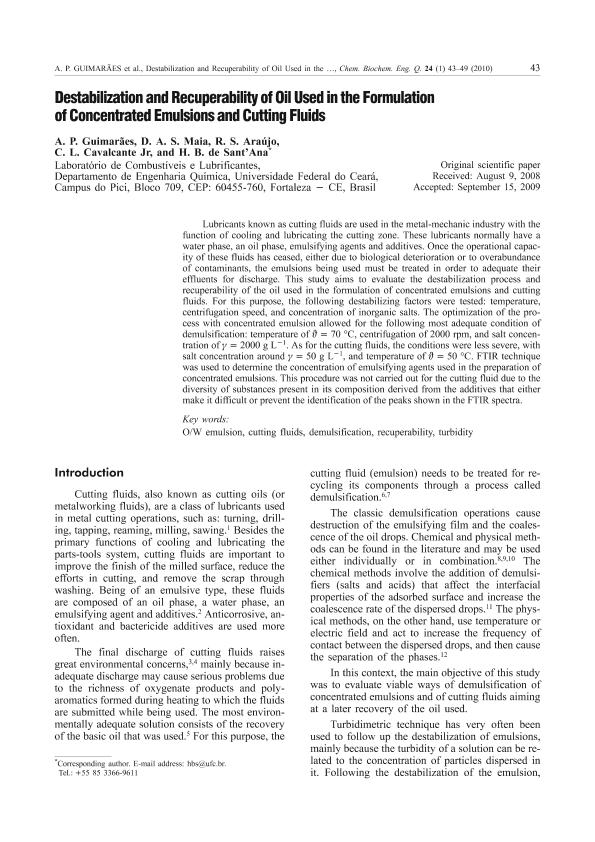Mostrar el registro sencillo del ítem
dc.contributor.author
Guimarães, A. P.
dc.contributor.author
Soares Maia, Debora Aline

dc.contributor.author
Araújo, R. S.
dc.contributor.author
Cavalcante Jr., C. L.
dc.contributor.author
Sant' Ana, H. B. de
dc.date.available
2017-03-31T18:09:07Z
dc.date.issued
2010-01
dc.identifier.citation
Guimarães, A. P.; Soares Maia, Debora Aline; Araújo, R. S.; Cavalcante Jr., C. L.; Sant' Ana, H. B. de; Destabilization and recuperability of oil used in the formulation of concentrated emulsions and cutting fluids; Croatian Soc Chemical Engineering Technology; Chemical And Biochemical Engineering Quarterly; 24; 1; 1-2010; 43-49
dc.identifier.issn
0352-9568
dc.identifier.uri
http://hdl.handle.net/11336/14606
dc.description.abstract
Lubricants known as cutting fluids are used in the metal-mechanic industry with the function of cooling and lubricating the cutting zone. These lubricants normally have a water phase, an oil phase, emulsifying agents and additives. Once the operational capacity of these fluids has ceased, either due to biological deterioration or to overabundance of contaminants, the emulsions being used must be treated in order to adequate their effluents for discharge. This study aims to evaluate the destabilization process and recuperability of the oil used in the formulation of concentrated emulsions and cutting fluids. For this purpose, the following destabilizing factors were tested: temperature, centrifugation speed, and concentration of inorganic salts. The optimization of the process with concentrated emulsion allowed for the following most adequate condition of demulsification: temperature of 70 °C, centrifugation of 2000 rpm, and salt concentration<br />of 2000 g /L. As for the cutting fluids, the conditions were less severe, with salt concentration around 50 g/L, and temperature of 50 °C. FTIR technique was used to determine the concentration of emulsifying agents used in the preparation of concentrated emulsions. This procedure was not carried out for the cutting fluid due to the diversity of substances present in its composition derived from the additives that either make it difficult or prevent the identification of the peaks shown in the FTIR spectra.
dc.format
application/pdf
dc.language.iso
eng
dc.publisher
Croatian Soc Chemical Engineering Technology

dc.rights
info:eu-repo/semantics/openAccess
dc.rights.uri
https://creativecommons.org/licenses/by/2.5/ar/
dc.subject
O/W Emulsion
dc.subject
Cutting Fluids
dc.subject
Demulsification
dc.subject
Recuperability
dc.subject.classification
Otras Ingeniería Química

dc.subject.classification
Ingeniería Química

dc.subject.classification
INGENIERÍAS Y TECNOLOGÍAS

dc.title
Destabilization and recuperability of oil used in the formulation of concentrated emulsions and cutting fluids
dc.type
info:eu-repo/semantics/article
dc.type
info:ar-repo/semantics/artículo
dc.type
info:eu-repo/semantics/publishedVersion
dc.date.updated
2017-03-20T14:12:05Z
dc.journal.volume
24
dc.journal.number
1
dc.journal.pagination
43-49
dc.journal.pais
Croacia

dc.description.fil
Fil: Guimarães, A. P.. Universidade Federal Do Ceara; Brasil
dc.description.fil
Fil: Soares Maia, Debora Aline. Universidade Federal Do Ceara; Brasil. Consejo Nacional de Investigaciones Científicas y Técnicas. Centro Científico Tecnológico San Luis. Instituto de Física Aplicada; Argentina; Argentina
dc.description.fil
Fil: Araújo, R. S.. Universidade Federal Do Ceara; Brasil
dc.description.fil
Fil: Cavalcante Jr., C. L.. Universidade Federal Do Ceara; Brasil
dc.description.fil
Fil: Sant' Ana, H. B. de. Universidade Federal Do Ceara; Brasil
dc.journal.title
Chemical And Biochemical Engineering Quarterly

dc.relation.alternativeid
info:eu-repo/semantics/altIdentifier/url/http://silverstripe.fkit.hr/cabeq/past-issues/article/259
Archivos asociados
